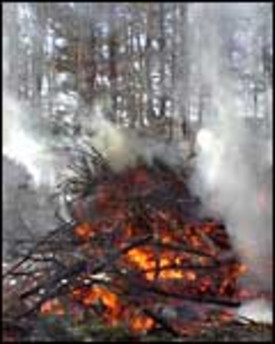If you live in the rural-urban interface, the point where homes meet combustible vegetation, you must increase your role to protect lives and property in your community beyond the city limits. People living in rural areas are more than twice as likely to die in a fire than those living in mid-sized cities or suburban areas. The misuse of wood stoves, portable space heaters and kerosene heaters are especially common risks in rural areas.
Wood Stoves
Wood stoves cause over 9,000 residential fires every year. Carefully follow the manufacturer’s installation and maintenance instructions. Look for solid construction, such as plate steel or cast iron metal. Check for cracks and inspect legs, hinges and door seals for smooth joints and seams. Use only seasoned wood for fuel, not green wood, artificial logs, or trash. Inspect and clean your pipes and chimneys annually and check monthly for damage or obstructions. Be sure to keep combustible objects at least three feet away from your wood stove.
Electric Space Heaters
Buy only heaters with the Underwriter’s Laboratory (UL) safety listing. Check to make sure it has a thermostat control mechanism, and will switch off automatically if the heater falls over. Heaters are not dryers or tables; don’t dry clothes or store objects on top of your heater. Space heaters need space; keep combustibles at least three feet away from each heater. Always unplug your electric space heater when not in use.
Kerosene Heaters
Buy only UL-approved heaters and check with your local fire department on the legality of kerosene heater use in your community. Never fill your heater with gasoline or camp stove fuel; both flare-up easily. Only use crystal clear K-1 kerosene. Never overfill any portable heater. Use the kerosene heater in a well ventilated room.
Fireplaces
Fireplaces regularly build up creosote in their chimneys. They need to be cleaned out frequently and chimneys should be inspected for obstructions and cracks to prevent deadly chimney and roof fires. Check to make sure the damper is open before starting any fire. Never burn trash, paper or green wood in your fireplace. These materials cause heavy creosote buildup and are difficult to control. Use a screen heavy enough to stop rolling logs and big enough to cover the entire opening of the fireplace to catch flying sparks. Don’t wear loose-fitting clothes near any open flame. Make sure the fire is completely out before leaving the house or going to bed. Store cooled ashes in a tightly sealed metal container outside the home.
Fire Facts about Rural Living
- Once a fire starts outdoors in a rural area, it is often hard to control. Wildland firefighters are trained to protect natural resources, not homes and buildings.
- Many homes are located far from fire stations. The result is longer emergency response times. Within a matter of minutes, an entire home may be destroyed by fire.
- Limited water supply in rural areas can make fire suppression difficult.
- Homes may be secluded and surrounded by woods, dense brush and combustible vegetation that fuel fires.
Tips For Making Your Property Fire Resistant
- Keep lawns trimmed, leaves raked, and the roof and rain-gutters free from debris such as dead limbs and leaves.
- Stack firewood at least 30 feet away from your home.
- Store flammable materials, liquids and solvents in metal containers outside the home at least 30 feet away from structures and wooden fences.
- Create defensible space by thinning trees and brush within 30 feet around your home.
- Landscape your property with fire resistant plants and vegetation to prevent fire from spreading quickly.
- Post home address signs that are clearly visible from the road.
- Provide emergency vehicle access with properly constructed driveways and roadways, at least 12 feet wide with adequate turnaround space.
- Make sure water sources, such as hydrants and ponds, are accessible to the fire department.
- Burning yard waste is a fire hazard. Check with your local fire agency on a non-emergency number for fire permit requirements and restricted burning times.
Protect Your Home
- Use fire resistant, protective roofing and materials like stone, brick and metal to protect your home. Avoid using wood materials that offer the least fire protection.
- Cover all exterior vents, attics and eaves with metal mesh screens no larger than 6 millimeters.
- Install multipane windows, tempered safety glass or fireproof shutters to protect large windows from radiant heat.
- Use fire-resistant draperies for added window protection.
- Have chimneys, wood stoves and all home heating systems inspected and cleaned annually by a certified specialist.
Prepare Your Family
- Know how to contact fire emergency services in your area.
- Plan ahead. Make sure you and your family are prepared for a fire emergency.
- Develop and practice escape and evacuation plans with your family.
- Install smoke alarms on every level of your home. Test them monthly and change the batteries at least once a year. Consider installing the new long-life smoke alarms.




























